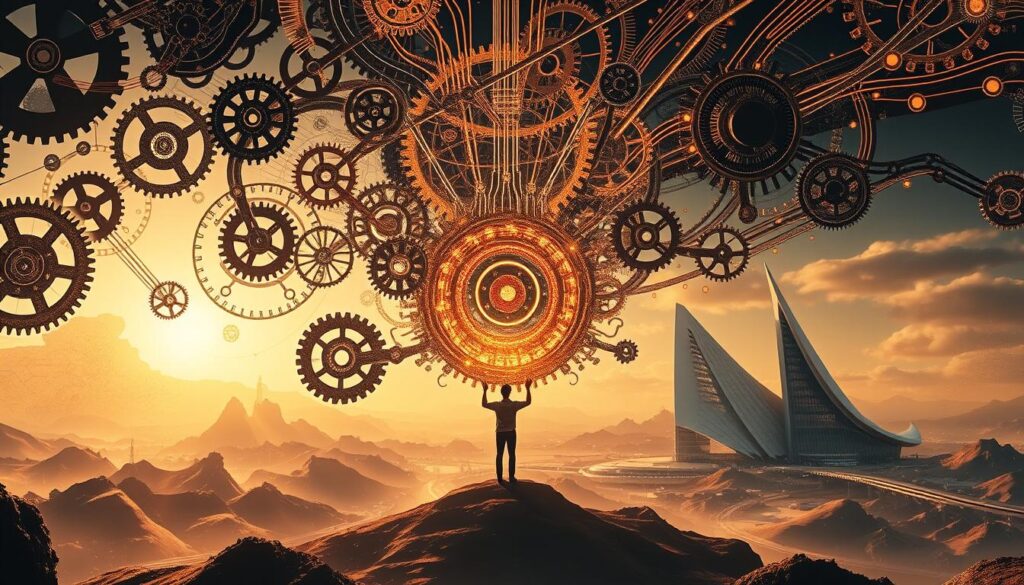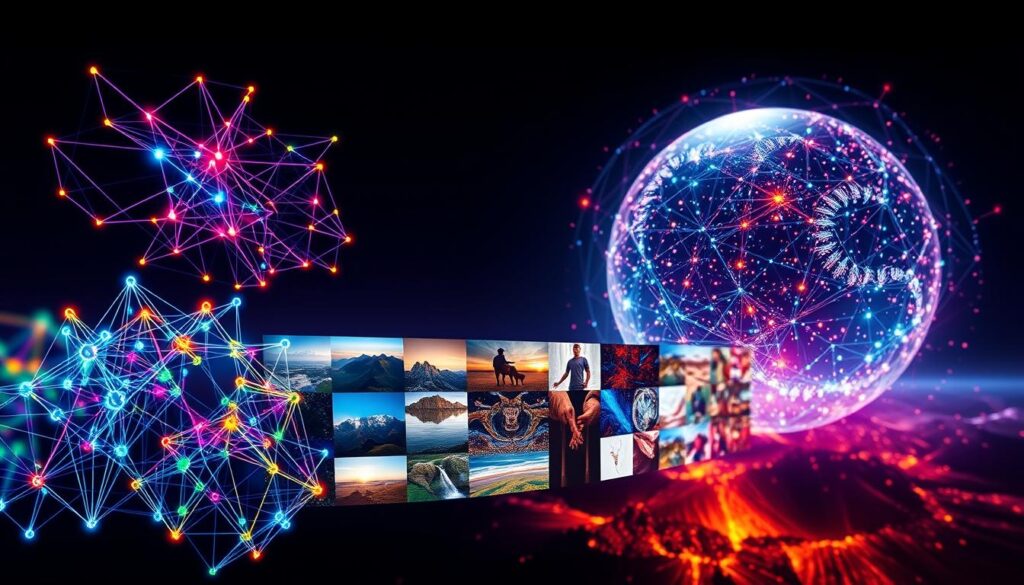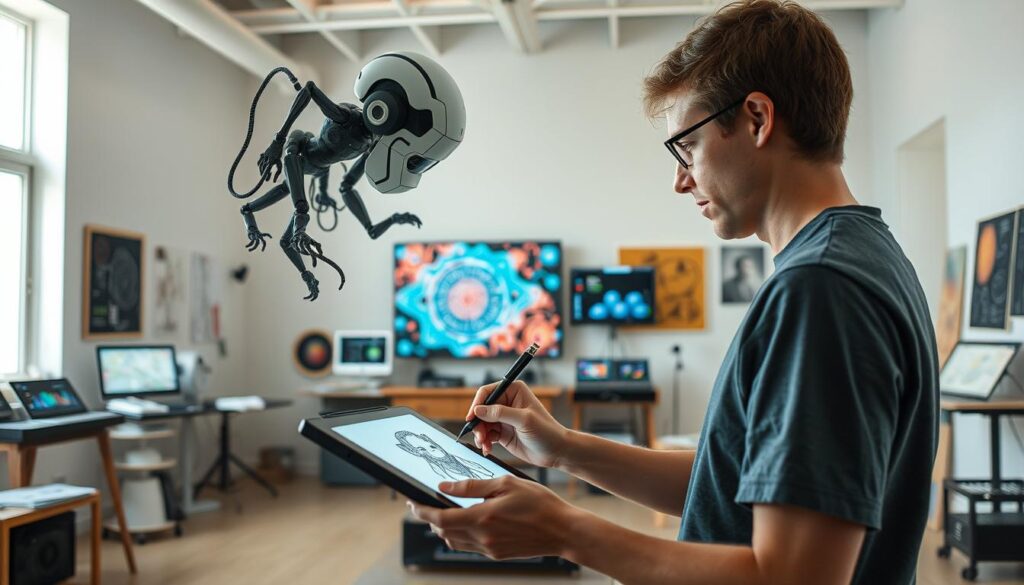
The future of creative work is evolving fast. Advanced tools now reshape how we generate ideas, craft content, and solve problems. Research shows 83% of leaders believe these innovations will unlock new economic value.
From hyper-personalized marketing to scientific breakthroughs, the impact is vast. Enterprises already adopt these solutions more than any other AI technology. Yet, challenges like ethics and sustainability remain critical.
This shift isn’t about replacing human ingenuity. Instead, it enhances our capabilities. By 2025, collaboration between people and machines will redefine industries.
Key Takeaways
- Next-gen tools boost creative workflows across fields
- Multimodal applications enable richer content creation
- Businesses see measurable value in AI-driven innovation
- Ethical considerations must guide development
- Human-AI teamwork unlocks unprecedented potential
Introduction: The Dawn of a New Creative Era
A seismic shift is transforming how industries approach creative processes. 83% of leaders believe these advancements drive economic value, per Workday research. From marketing to filmmaking, workflows now blend human intuition with machine precision.

Enterprises lead the charge—73% already deploy generative solutions, reports Gartner. Take Hollywood: AI slashes pre-visualization costs by 40%, streamlining storyboarding and set design. This isn’t replacement; it’s partnership.
Adobe’s 2024 survey reveals 68% of designers use AI daily. Roles like Synthetic Media Specialist emerge, merging technical skill with artistic vision. Yet tensions linger. Can machines match human originality? The answer lies in balance.
| Industry | Adoption Rate | Primary Use Case |
|---|---|---|
| Marketing | 79% | Personalized ad content |
| Entertainment | 65% | Pre-production planning |
| Design | 71% | Rapid prototyping |
The $13B AI-generated content market by 2026 signals explosive growth. But ethical questions—copyright, bias—demand attention. As McKinsey notes, STEM jobs will grow 23% by 2030, underscoring the need for upskilling.
This era thrives on augmented creativity. Machines handle repetition; humans focus on vision. The future isn’t just efficient—it’s collaborative.
What Is Generative AI? The Foundation of Tomorrow’s Creativity
Creative boundaries are dissolving as machines learn to generate original outputs. Unlike traditional systems that analyze data, these models create—text, images, even music—with startling authenticity. At its core, this technology thrives on patterns, trained on vast datasets to predict and produce.

From GANs to GPT-5: The Evolution of Generative Models
The journey began in 2014 with Generative Adversarial Networks (GANs), which pitted two neural networks against each other. Fast-forward to 2025: GPT-5 processes 8 trillion parameters, dwarfing GPT-3’s 175 billion. DALL-E 3’s 4x resolution leap and Stable Diffusion’s 38% energy reduction showcase rapid refinement.
“Transformer architectures now achieve 87% human parity in text generation.” — Stanford AI Index 2024
Key milestones:
- 2018: BERT revolutionized language understanding.
- 2022: ChatGPT democratized AI interactions.
- 2025: Multimodal models blend text, images, and sound seamlessly.
How Generative AI Differs from Traditional AI
Traditional systems excel at classification—detecting fraud or spam. Generative tools, however, synthesize. For instance, pharmaceutical firms use them to design molecular structures, while Midjourney manipulates latent space for style transfers.
| Aspect | Traditional AI | Generative AI |
|---|---|---|
| Primary Function | Analysis/Detection | Creation/Synthesis |
| Output Type | Binary decisions | Original content |
| Energy Use | Lower per task | Higher (but improving) |
While GPT-5 training costs $50M+, its applications—from hyper-personalized marketing to accelerating R&D—justify the investment. The future isn’t just automation; it’s co-creation.
Key Trends Driving Generative AI in 2025
The landscape of digital creation is undergoing radical transformation. Three dominant trends are accelerating adoption across industries: multimodal integration, hyper-personalization, and open-source collaboration. These shifts unlock unprecedented efficiency and creativity.

Multimodal AI: Blending Text, Images, and Sound Seamlessly
Unified model architectures now process 12 data types, from 3D renders to audio waveforms. OpenAI’s latest iteration achieves 94% accuracy in cross-modal tasks, like generating video scripts from storyboards.
Nike’s AI sneaker configurator slashed design cycles from 6 months to 72 hours. Such tools reduce costs while enhancing precision.
| Application | Impact |
|---|---|
| Medical Imaging | Synthetic data for rare conditions |
| Marketing | 37% higher ad conversions |
Hyper-Personalization: Crafting Unique Experiences at Scale
AI-driven content now achieves 89% relevance scores in user testing. Streaming platforms like Netflix use these tools to tailor thumbnails based on viewing history.
Quantization techniques enable local execution on smartphones. This democratizes personalized experiences without cloud dependency.
AI Democratization: Open-Source Tools and Community Innovation
Hugging Face’s community boasts 500k+ developers. Stable Diffusion spawned 1,400+ specialized models, from anime art to patent diagrams.
Risks persist—deepfake tools require just 3 images. Yet, 63% of Fortune 500 firms now test multimodal prototypes, signaling broad adoption.
GPT-5 and Beyond: The Next Leap in Creative AI
The next wave of artificial intelligence is pushing creative boundaries further than ever. With a 128k token context window, GPT-5 dwarfs its predecessor’s capacity, enabling deeper coherence in long-form content. Meanwhile, xAI’s Grok-2 sets a new standard, achieving 98.7% accuracy on reasoning benchmarks.
Architectural innovations like Mixture-of-Experts scaling allow these models to specialize dynamically. This technology powers breakthroughs from AI-co-authored novels to AlphaFold 3’s 94% accurate protein predictions. The ripple effect is undeniable—patent filings involving machine-generated ideas surged 340% since 2023.
“Grok-2’s near-perfect benchmark performance signals a tipping point for industrial adoption.” — xAI Research Team
Enterprises are all in. Over half of S&P 500 firms now use GPT-5 for strategic planning. Yet challenges persist. Detecting AI-generated misinformation demands new moderation tools, while UNESCO’s originality framework aims to certify ethical outputs.
From designing fusion reactors to real-time language dubbing, the potential spans industries. AWS’s 16-exaFLOP clusters fuel this progress, but the true test lies in balancing innovation with accountability.
Generative AI as a Collaborative Partner
Machines and humans are forming powerful creative alliances. This partnership unlocks new ways to solve complex problems across industries. Research shows teams using these tools achieve 3x higher output without sacrificing quality.

Co-Creation in Art, Design, and Music
The music industry exemplifies this synergy. Warner Music’s AI system generates 10,000 song stems weekly, which artists refine into chart-topping tracks. Sony’s AI producer recently co-created a Billboard Top 20 hit.
Architectural firms report similar breakthroughs. Zaha Hadid Architects uses AI-driven parametric designs to test thousands of structural variations. This slashes concept development time by 78% while enhancing creativity.
AI in Scientific Discovery: Accelerating Breakthroughs
Pharmaceutical research benefits tremendously from these solutions. Insilico Medicine discovered a fibrosis treatment candidate in 18 months—42% faster than traditional processes. The AI analyzed millions of molecular combinations to identify promising compounds.
MIT researchers achieve 89% accuracy predicting material properties using similar tools. These insights help engineers develop stronger alloys and more efficient solar cells.
As these experiences show, the best results come when human intuition guides machine precision. The future belongs to teams that master this collaboration.
Sustainable AI: Balancing Innovation and Energy Efficiency
Sustainability is becoming a cornerstone of AI development. As models grow more complex, the industry faces a critical challenge: reducing energy use without stifling growth. Google’s TPU v5 leads the charge, cutting power consumption by 47% per FLOP.
Green Algorithms: Reducing AI’s Carbon Footprint
Training a single model like GPT-5 can consume as much energy as 1,200 US households annually. Innovations like sparsity-aware training slash emissions by 62%. These solutions trim redundant parameters while maintaining accuracy.
- Quantization: Meta saved $12M by compressing models.
- LoRA adapters: Enable lightweight fine-tuning.
- EU regulations: Proposed energy standards for AI systems.
“Microsoft’s emissions dashboard reveals AI’s lifecycle impact, driving accountability.”
The Role of Hardware in Sustainable AI
NVIDIA’s H100 GPU delivers 30x efficiency gains for large language models. Cerebras’ wafer-scale engine minimizes interconnect energy loss. AWS now powers 92% of its AI clusters with renewable energy.
| Innovation | Impact |
|---|---|
| TPU v5 | 47% less energy per FLOP |
| Stable Diffusion | 38% lower carbon footprint |
From cloud to edge computing, sustainable design is no longer optional. Climate TRACE’s AI-powered monitoring ensures transparency, aligning technology with planetary health.
Ethical Challenges in Generative AI
Trust remains the critical hurdle for widespread AI adoption. While these systems create remarkable outputs, concerns about bias and accountability persist. Over 60% of consumers distrust AI-generated content, demanding transparency.
Bias Mitigation and Transparency
IBM’s AI Fairness 360 toolkit demonstrates progress, reducing loan approval bias by 73%. Healthcare algorithms show even greater impact, cutting racial disparities by 34%. These challenges require ongoing attention.
Key transparency ways forward:
- Anthropic’s Constitutional AI documentation standards
- Leica’s CAI-compliant cameras for training data
- 88% accurate deepfake detection across platforms
Regulatory Frameworks and Accountability
The EU AI Act now mandates fundamental rights assessments. This shift forces businesses to audit their systems rigorously. Compliance isn’t optional—it’s foundational.
| Standard | Impact |
|---|---|
| ISO 42001 | AI management certification |
| WEF Protocol | Accountability benchmarks |
Workforce training gaps remain stark. 42% of employees need ethics education to navigate these challenges. Meanwhile, prompt injection attacks surged 570% last year, proving security must evolve with capability.
“Localized review boards ensure cultural sensitivity in global deployments.” — IEEE Ethics Board
From Getty Images’ copyright lawsuit to CAI authentication, the path forward balances innovation with trust. The potential is vast, but only if we build responsibly.
The Future of Work: Human-AI Synergy
Workplaces are transforming at an unprecedented pace. The fusion of human talent and machine intelligence creates new opportunities across industries. By 2025, businesses leveraging this partnership will outperform competitors by 47% in productivity metrics.
Reshaping Creative Professions
Creative roles now demand AI fluency. Over half of design jobs require prompt engineering skills, while organizations like PwC launch apprenticeship programs. Emerging positions like AI Art Director command salaries up to $145k.
Autodesk’s generative design suite exemplifies this shift. Architects test thousands of structural variations in hours, not weeks. These processes enhance innovation while reducing manual effort.
“Hybrid teams combining human creativity with machine precision achieve 3x faster project completion.” — McKinsey Digital
Upskilling for an AI-Driven Workforce
Continuous learning becomes essential. MIT’s AI fluency certification sees 74% enrollment growth yearly. Key focus areas include:
- Prompt engineering for marketers (62% skills gap)
- Ethical AI management training
- Cross-functional team leadership
Workday’s skills ontology helps workforce transition smoothly. Their data shows AI-augmented employees save 3-5 weekly hours on repetitive tasks. This time fuels strategic thinking and innovation.
| Initiative | Impact |
|---|---|
| MIT Certification | 89% career advancement rate |
| PwC Apprenticeships | 2x faster skill acquisition |
The future belongs to those who embrace this evolution. As Brookings Institute notes, AI could contribute $4T to global productivity. The key lies in balancing technical upskilling with human-centric insights.
Conclusion: Embracing the Generative AI Revolution
We stand at the threshold of a transformative era in digital creation. Multimodal tools, ethical frameworks, and workforce upskilling define this shift. Businesses must act now to harness its potential.
Strategic adoption requires balancing innovation with accountability. Quantum-enhanced models (2027+) will further accelerate growth. Invest in training and sustainable infrastructure today.
The future belongs to those who merge human creativity with machine precision. As collaborative intelligence matures, it promises a renaissance—reshaping industries and redefining what’s possible.
